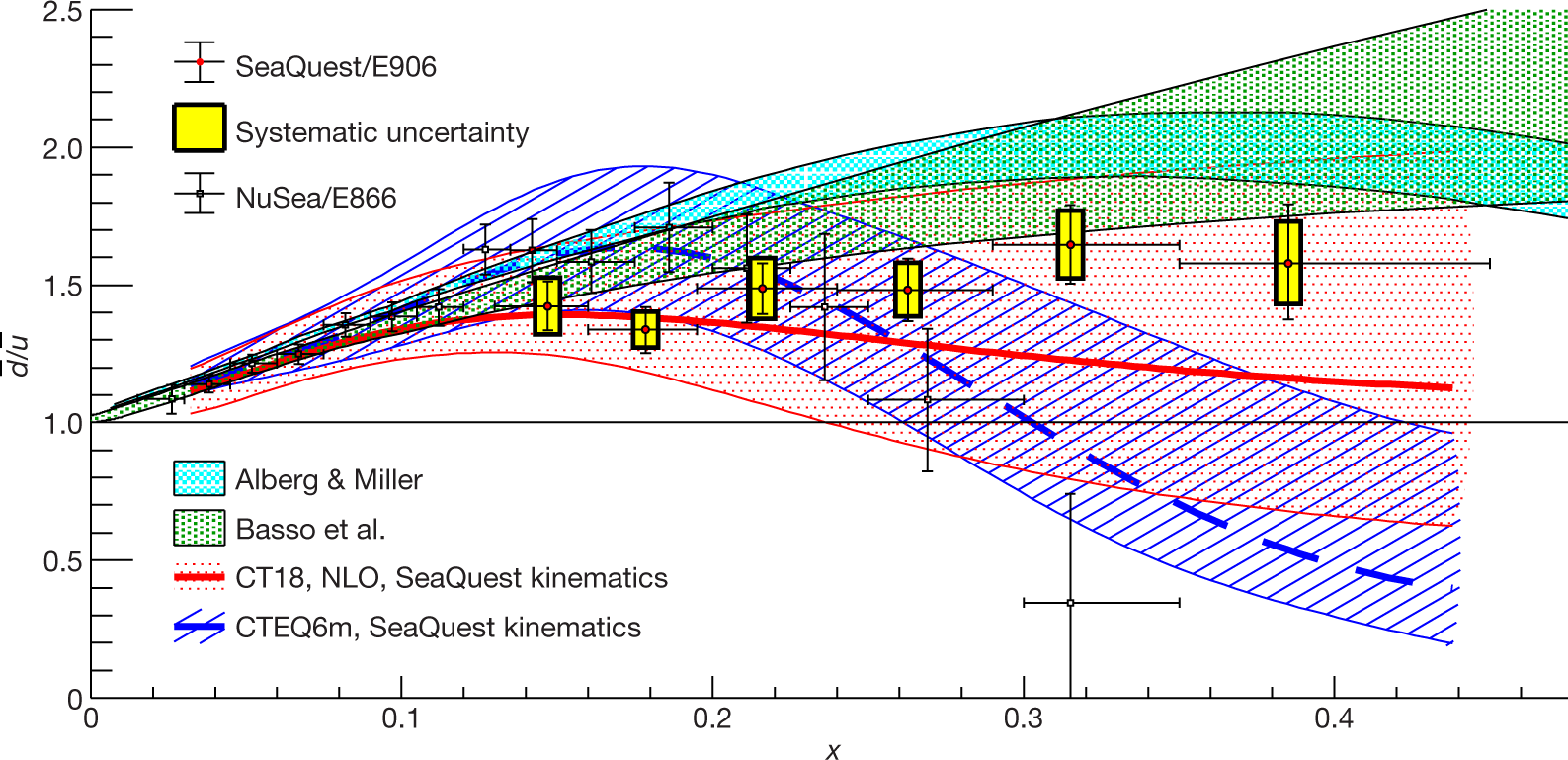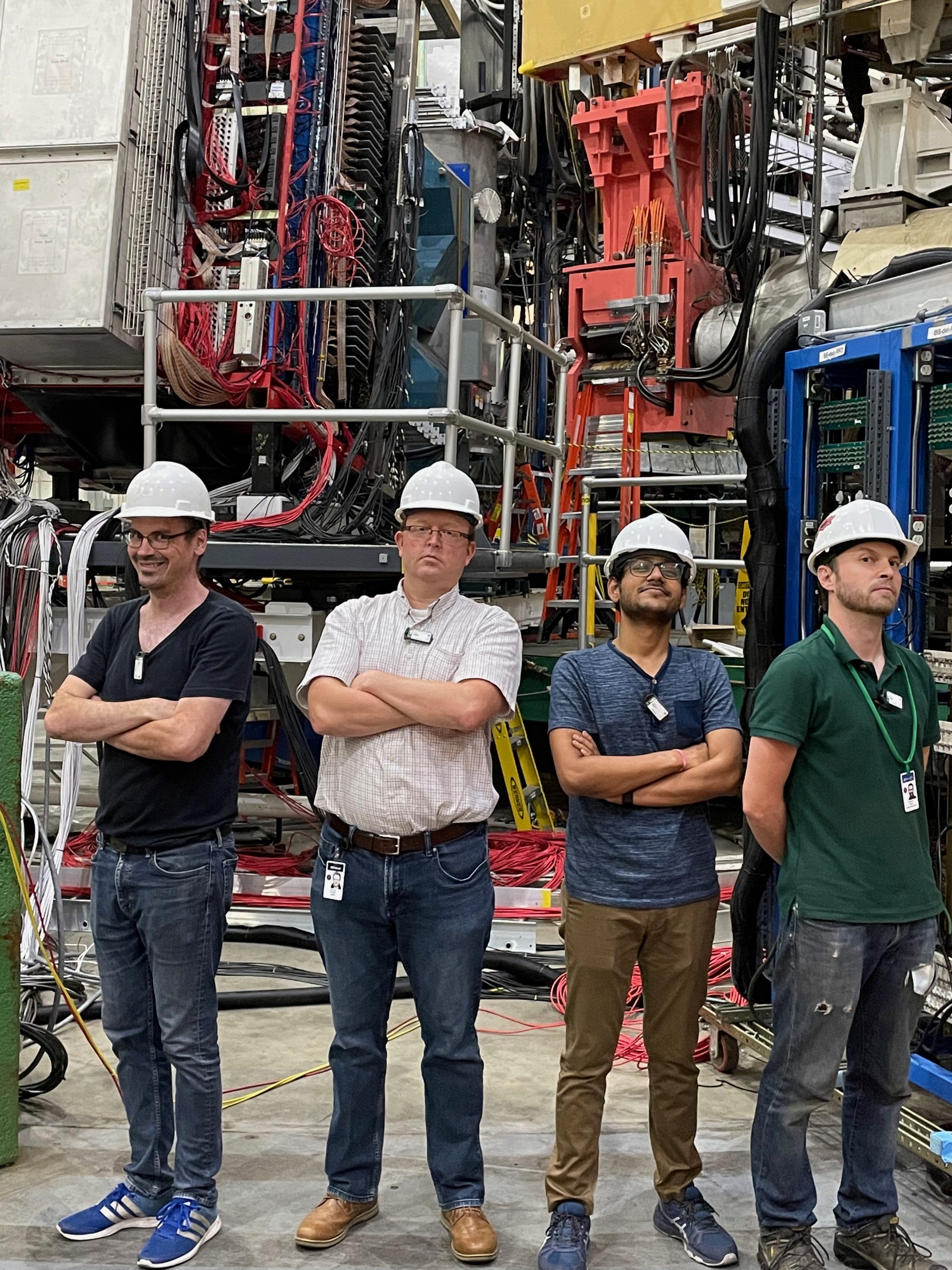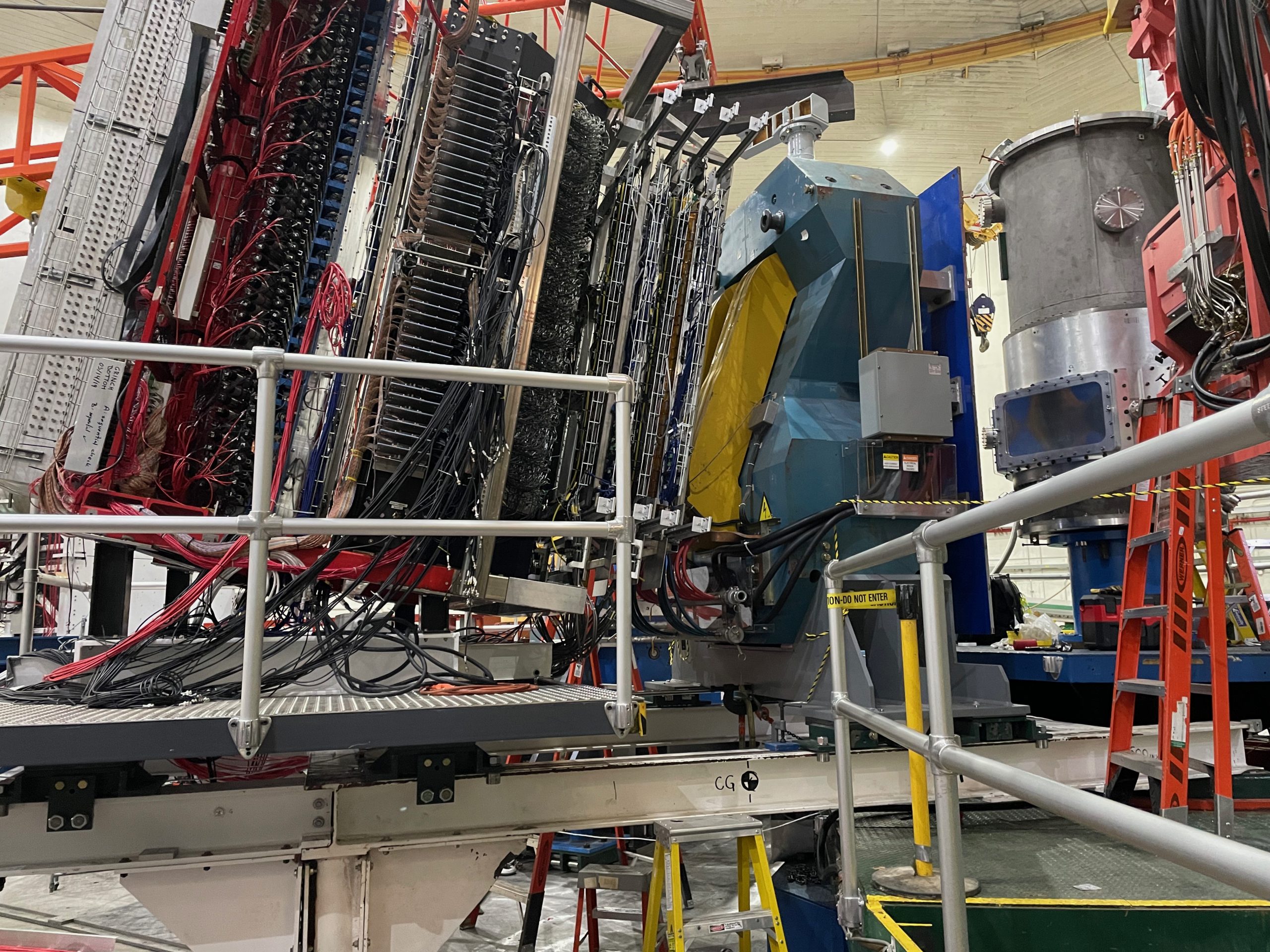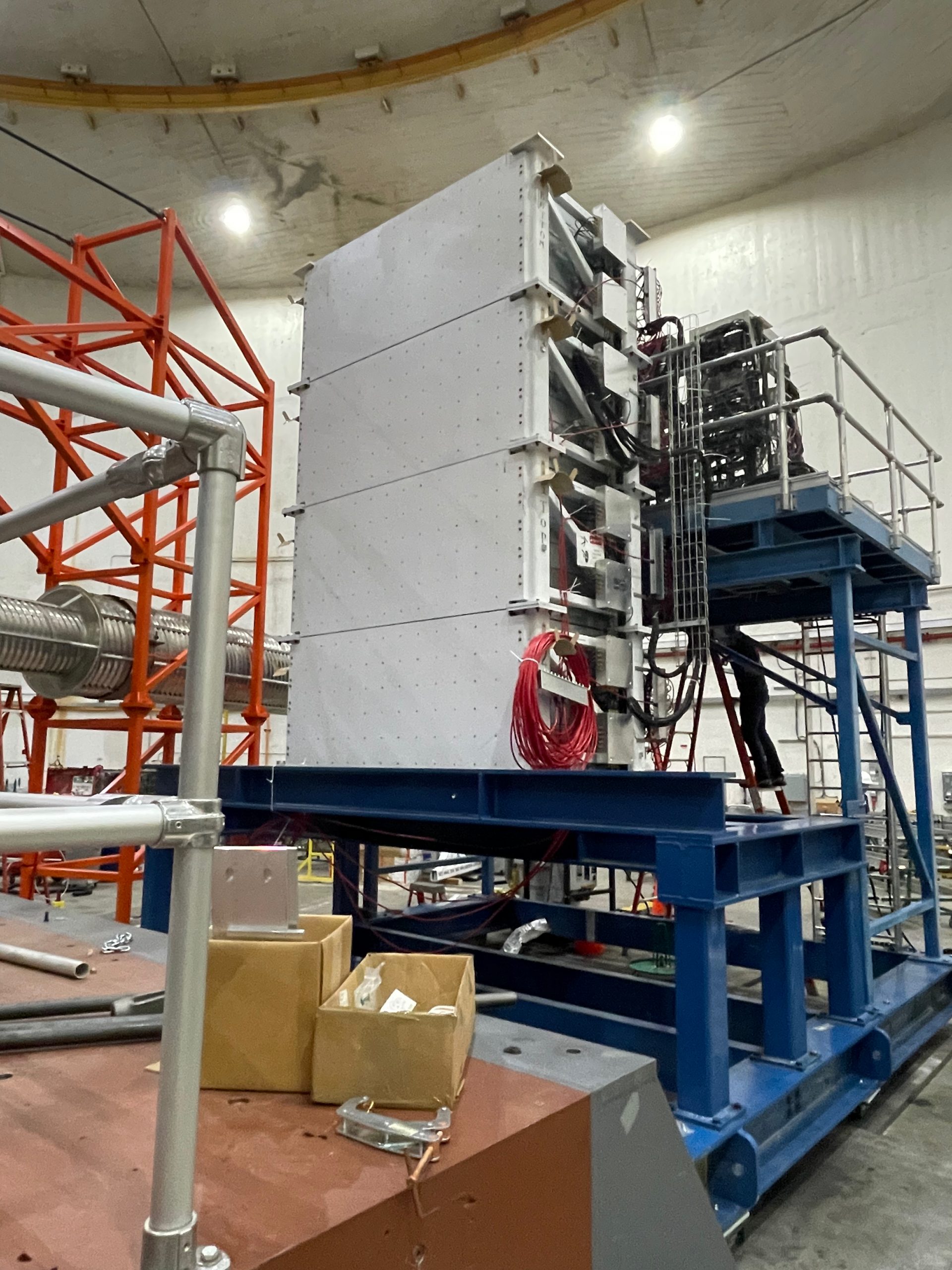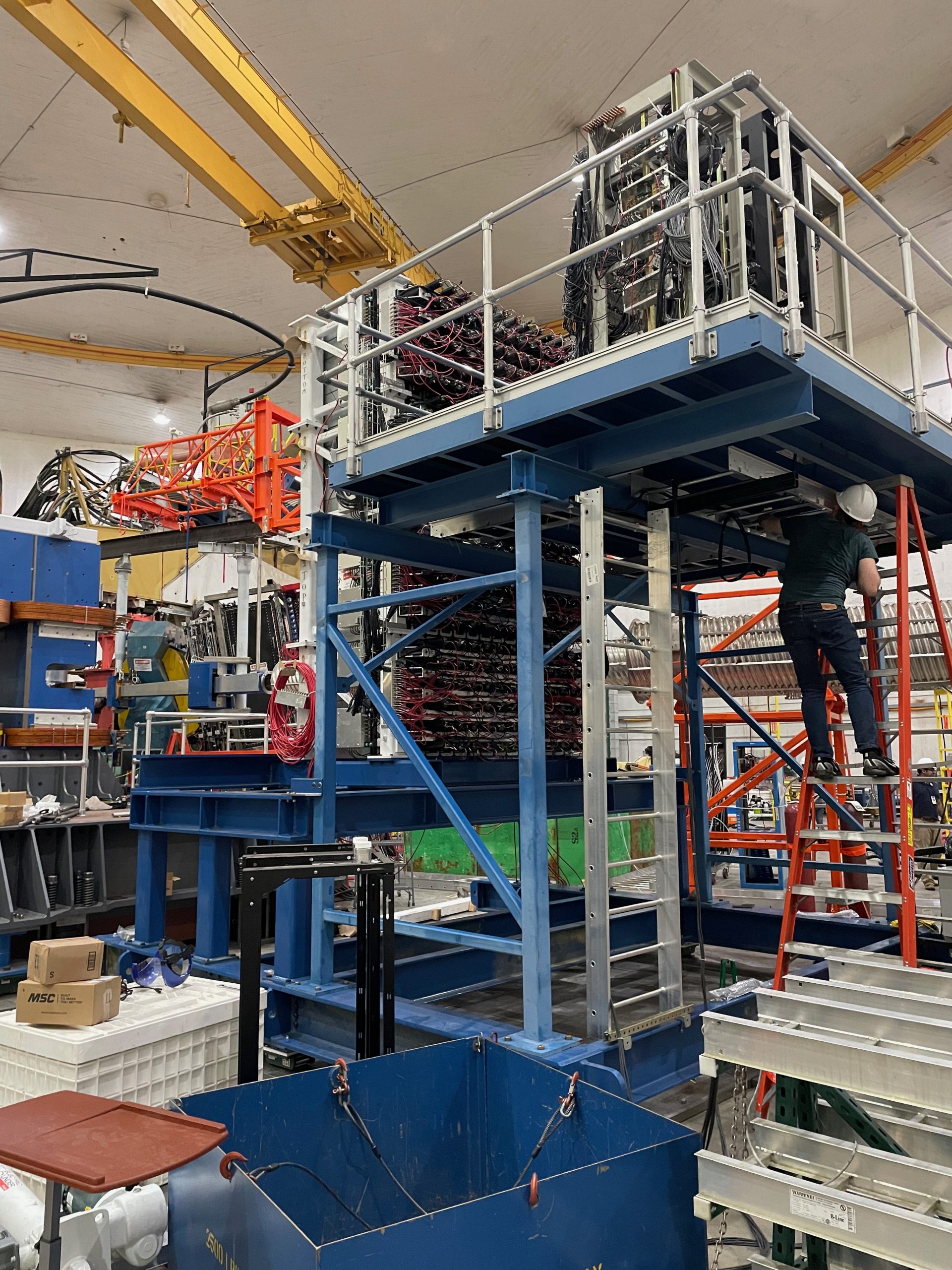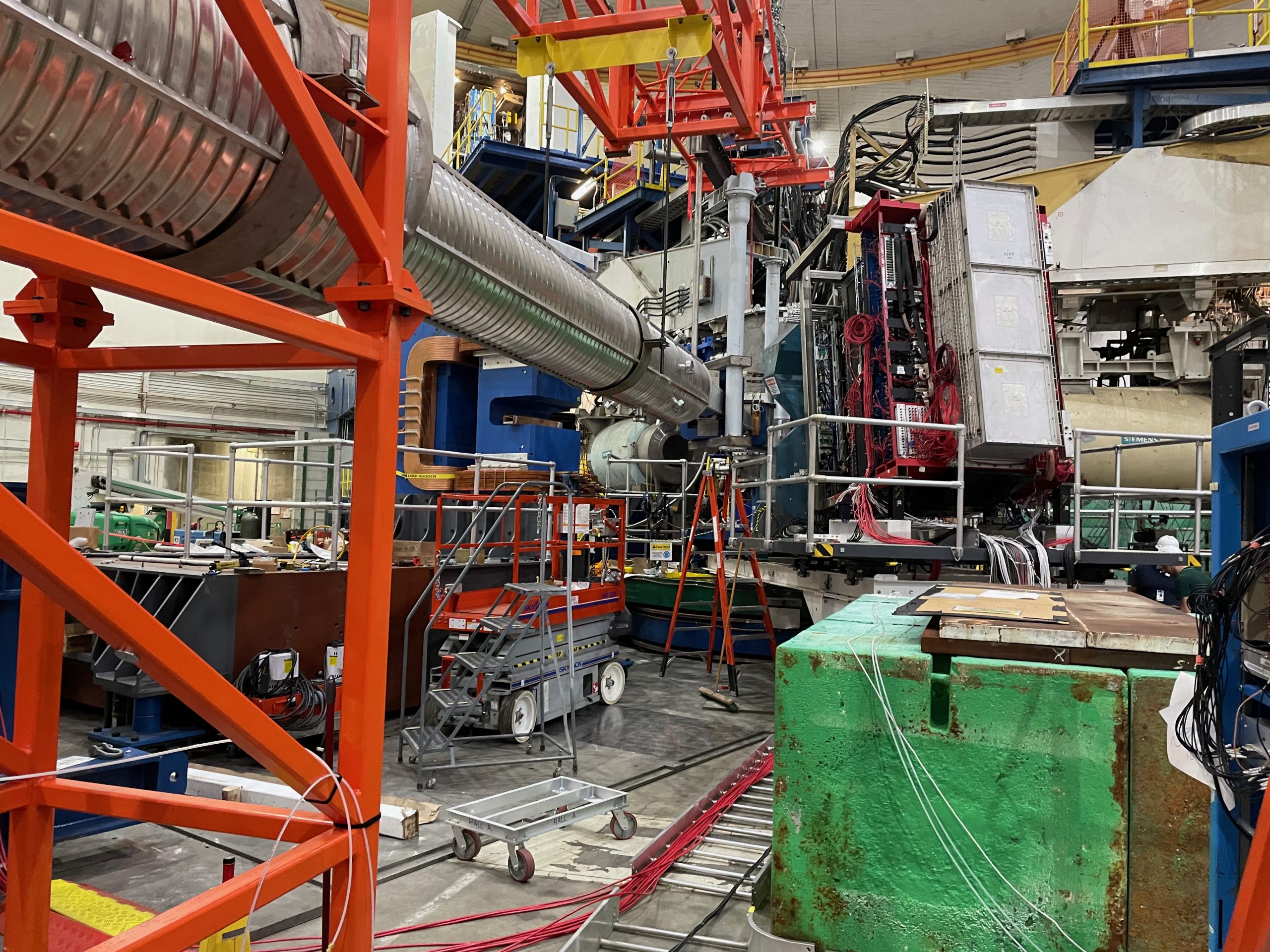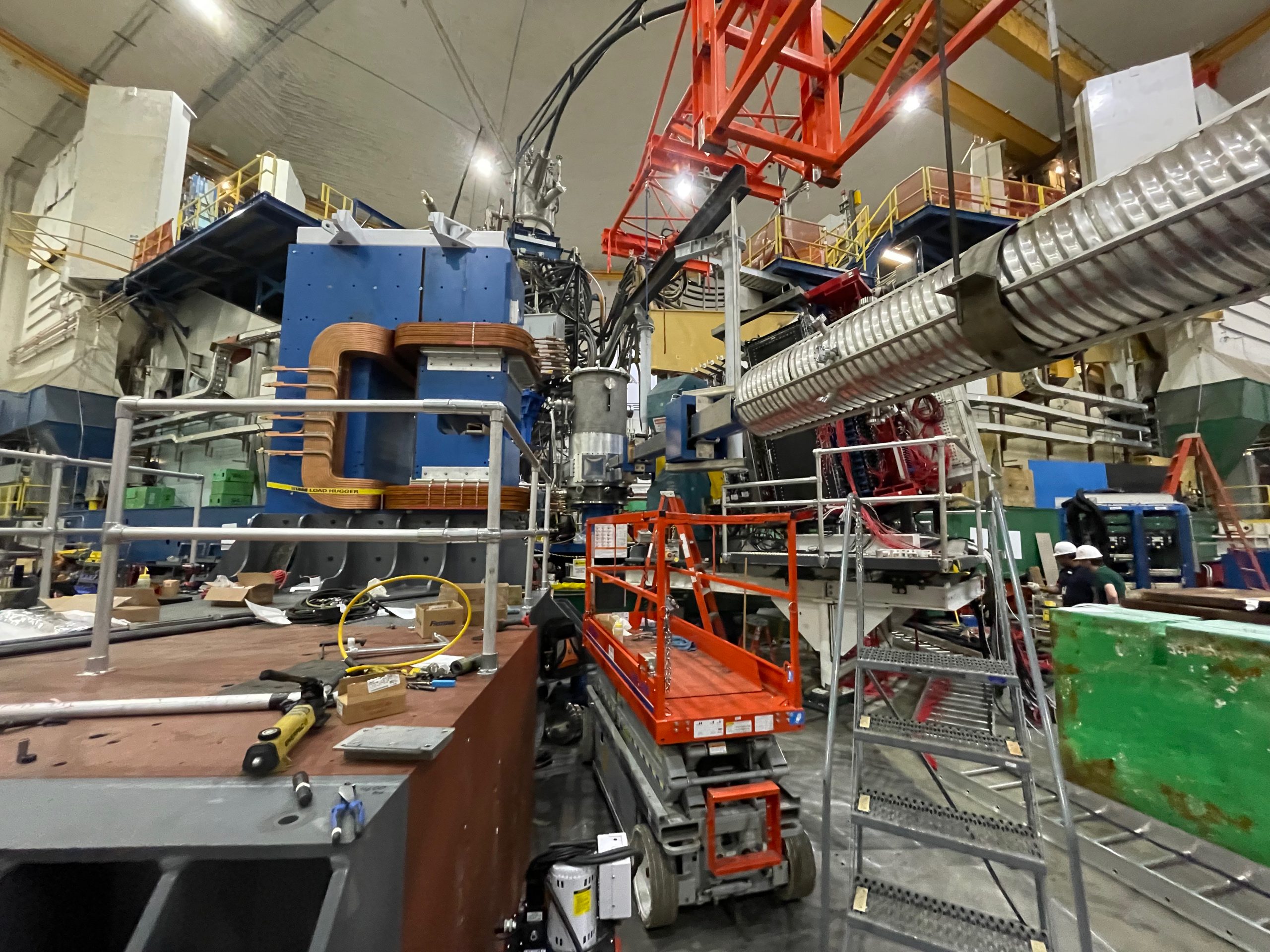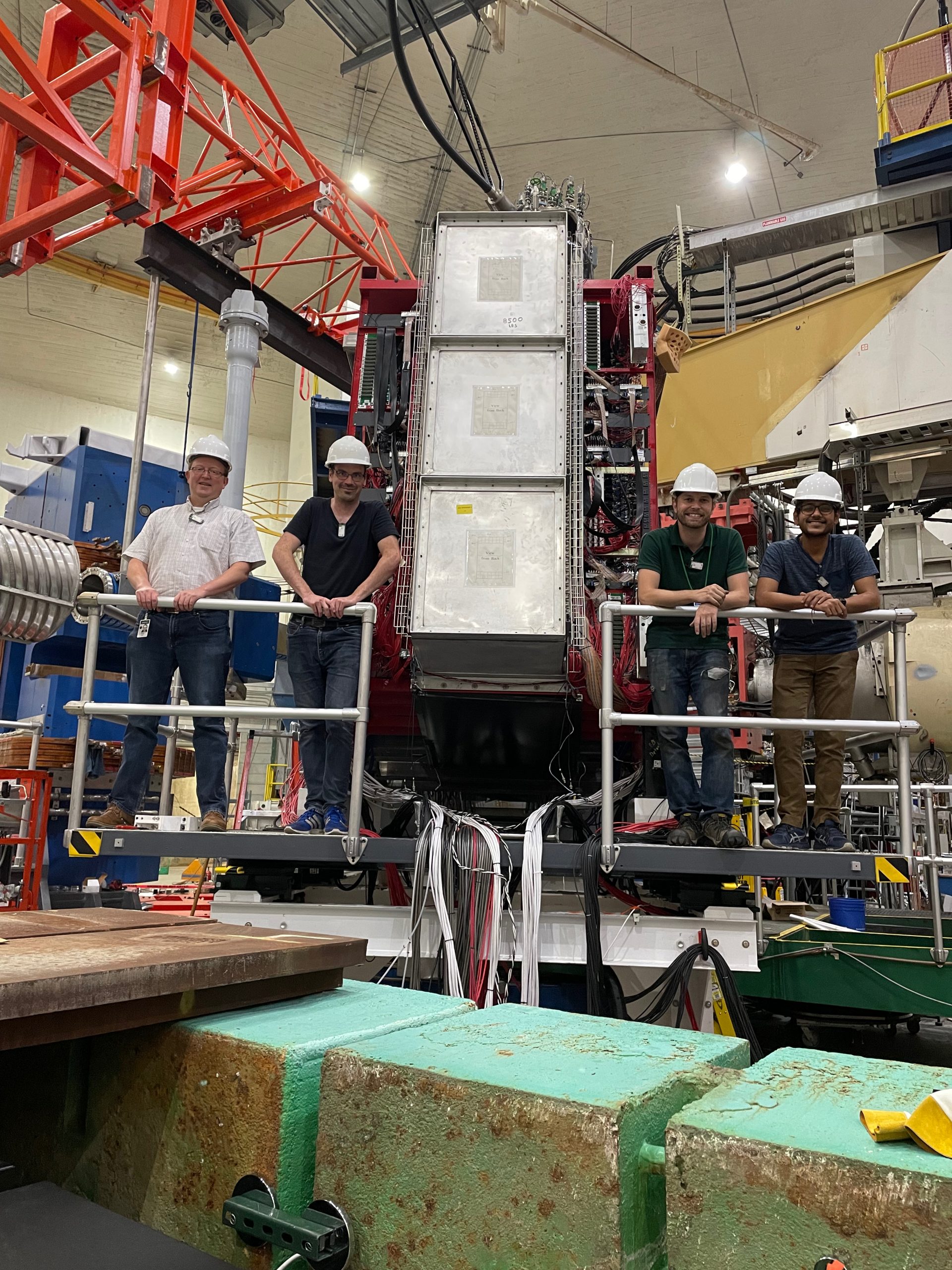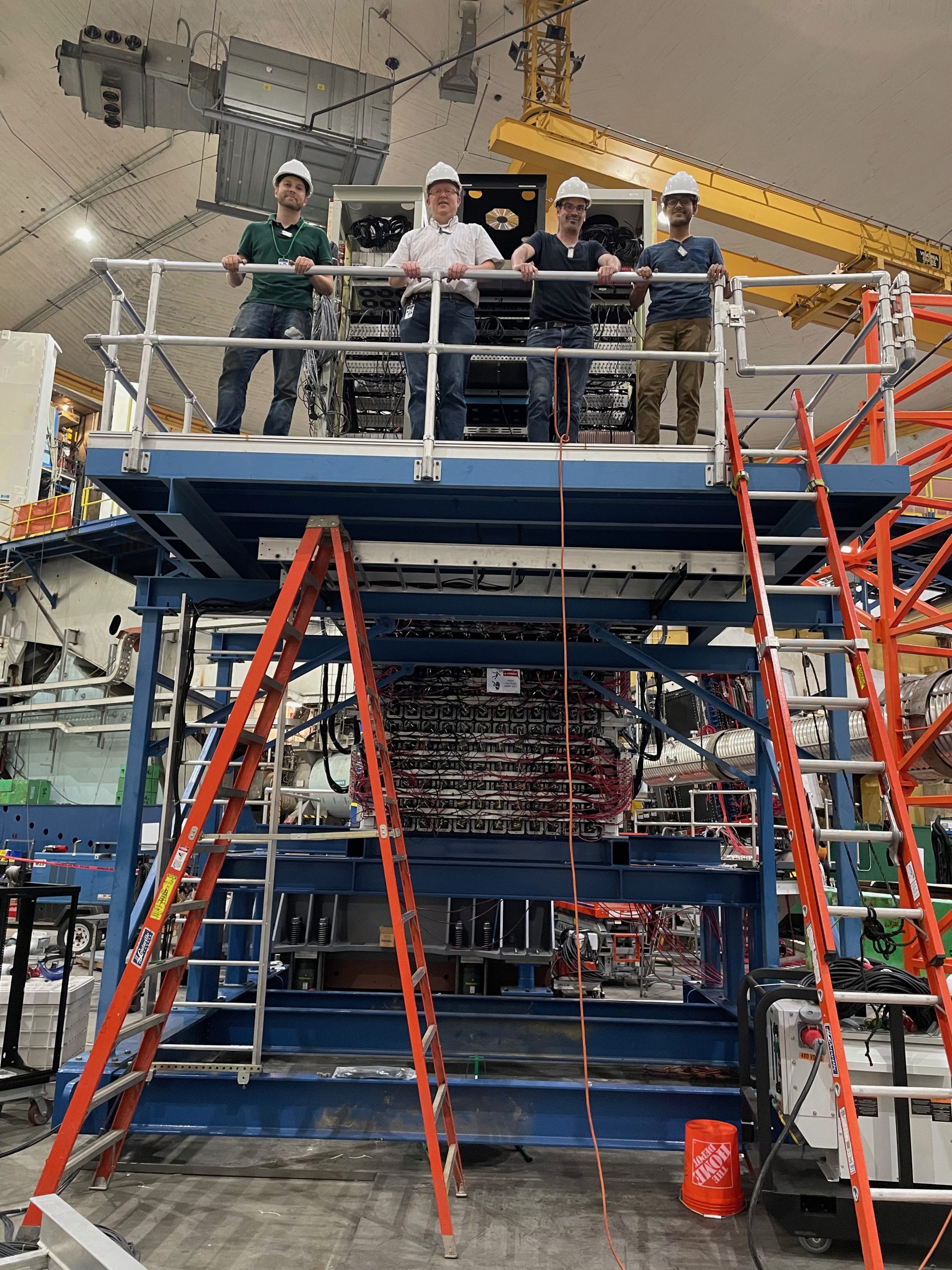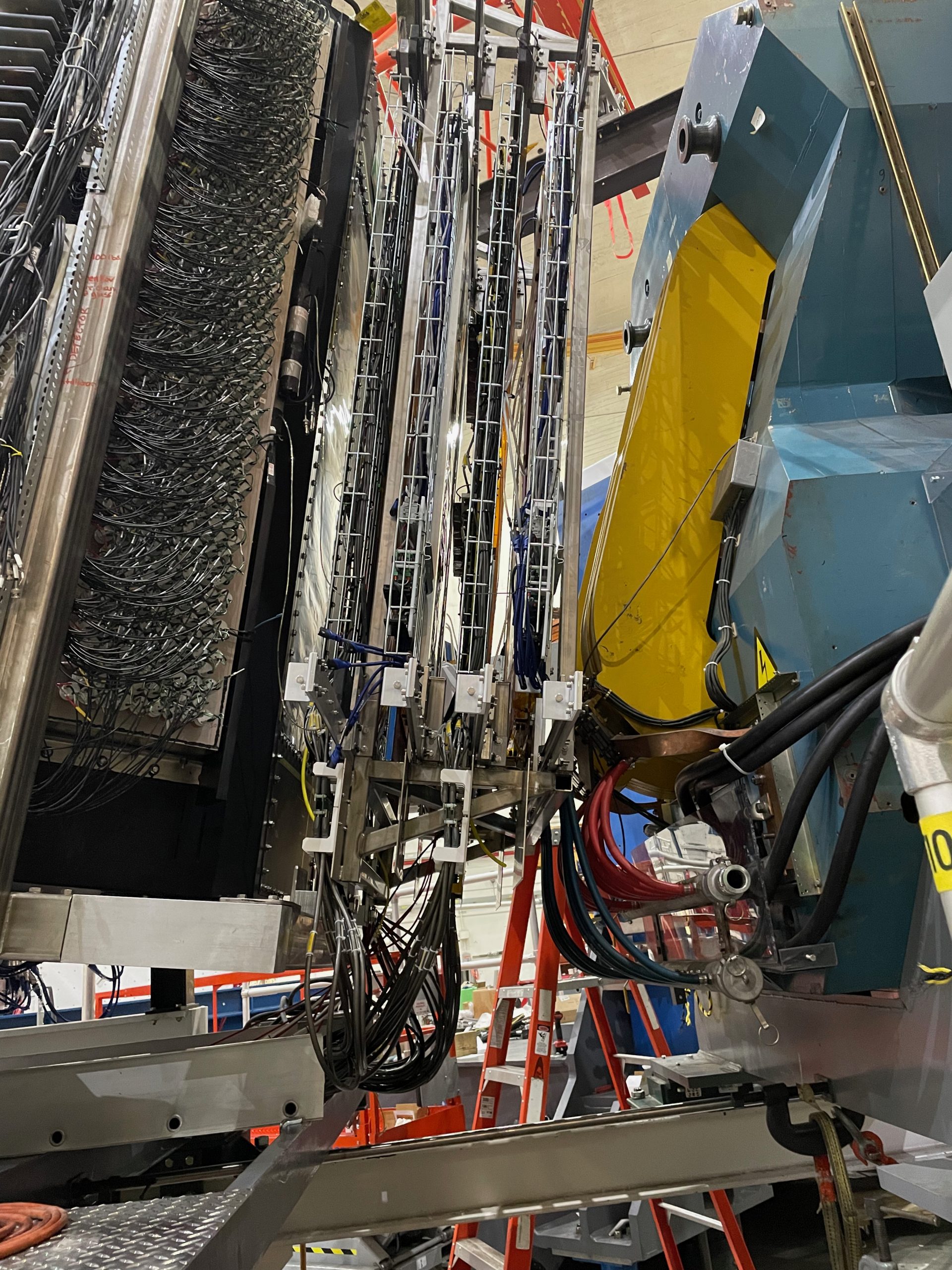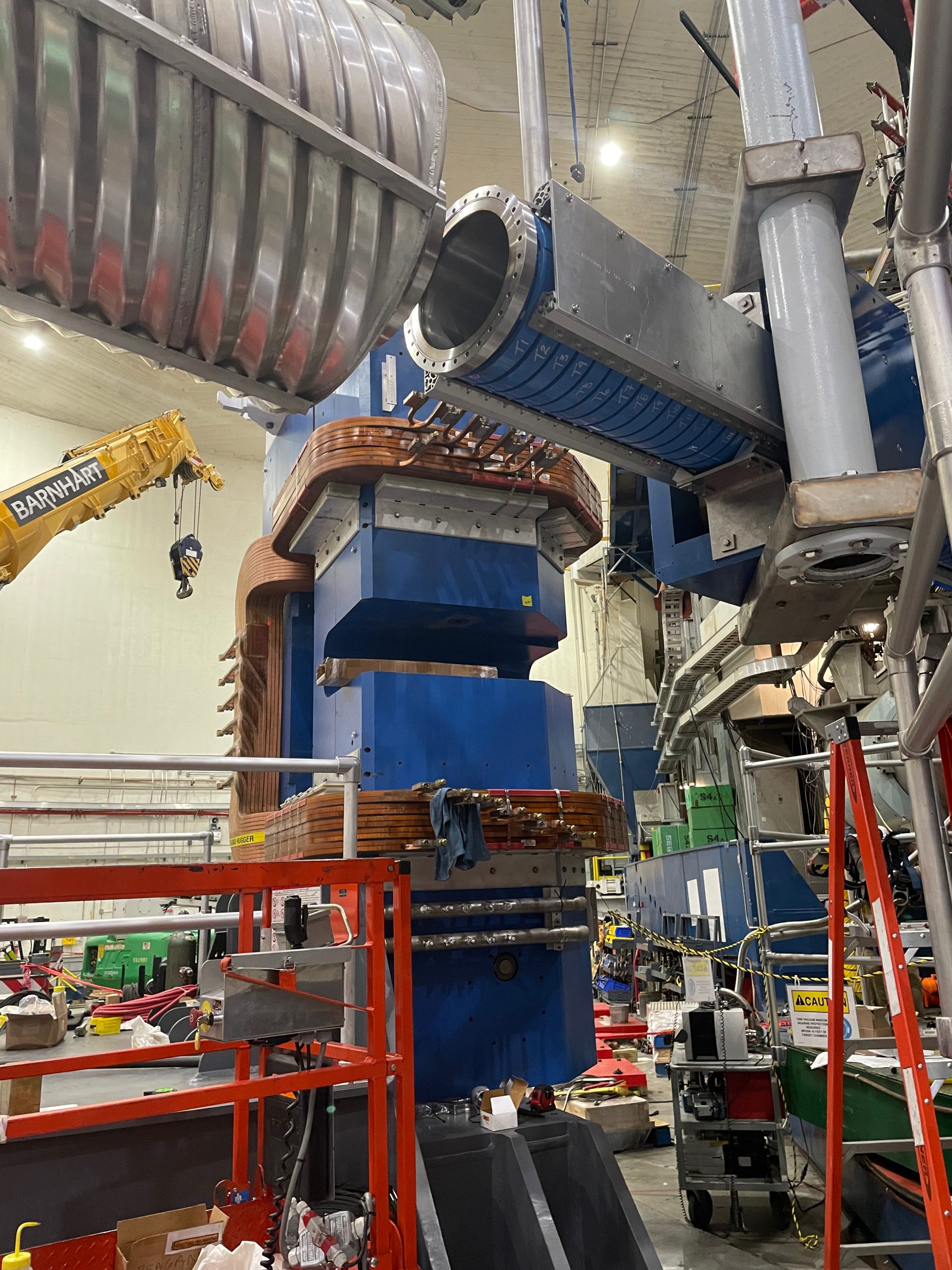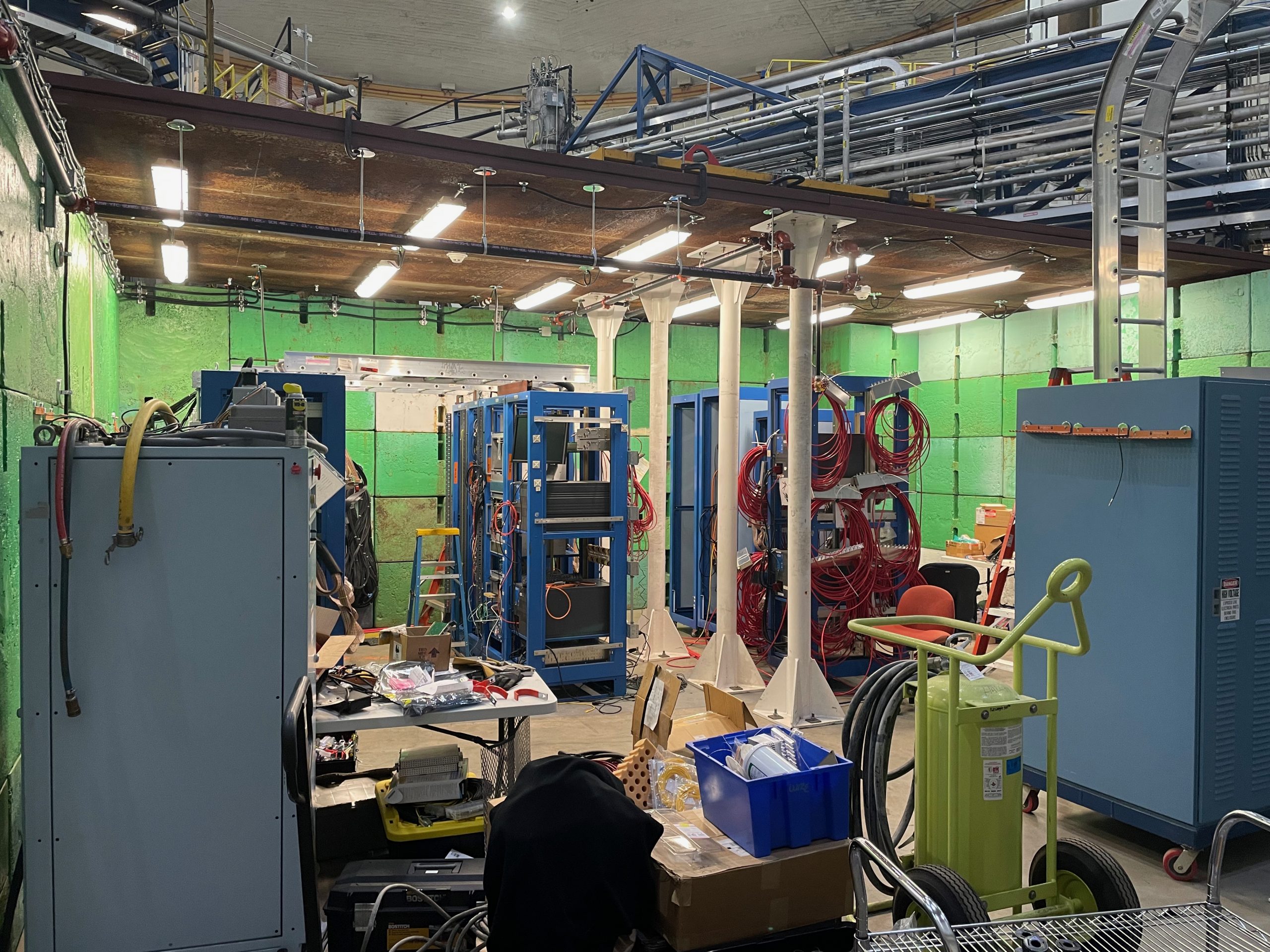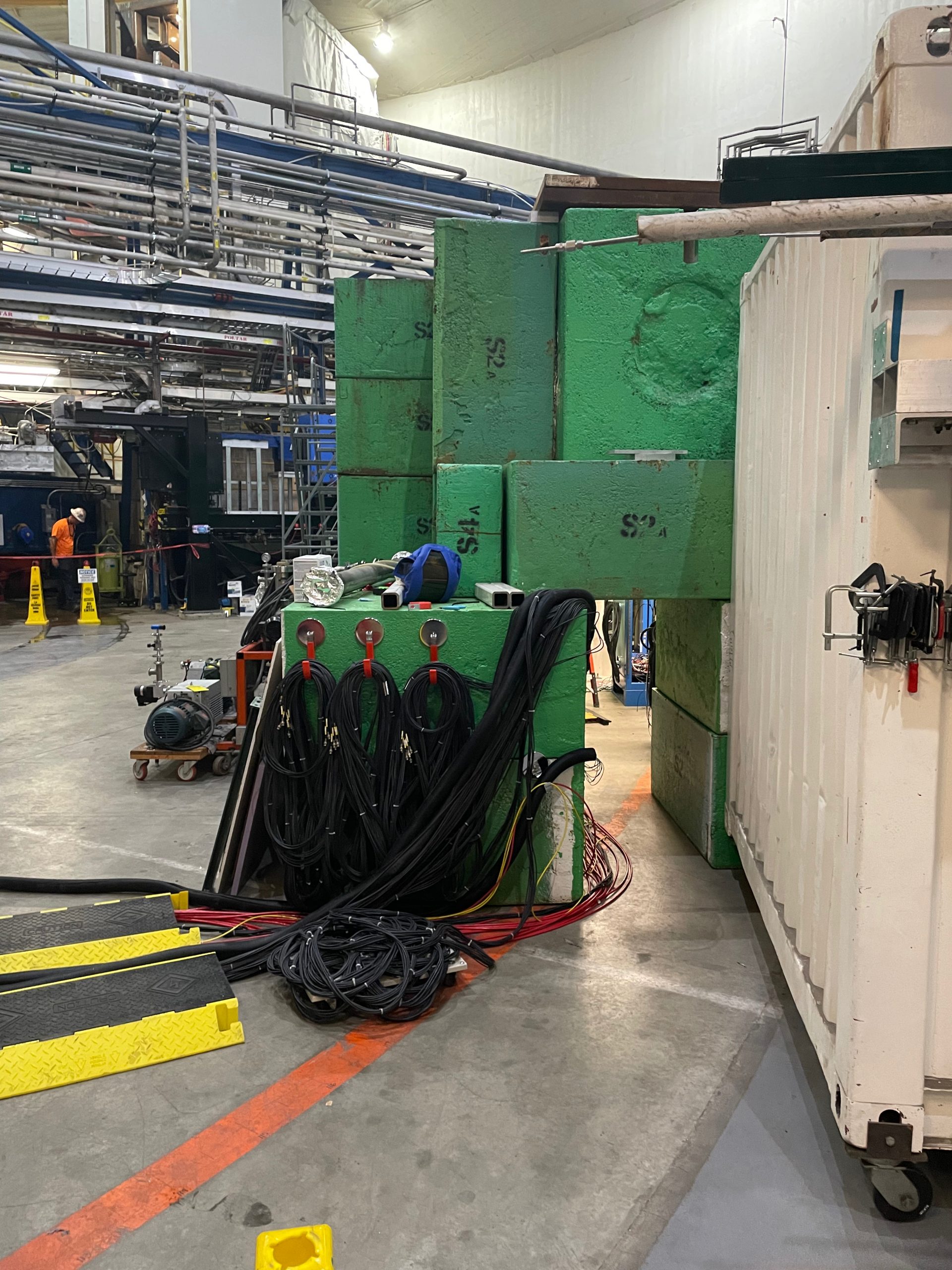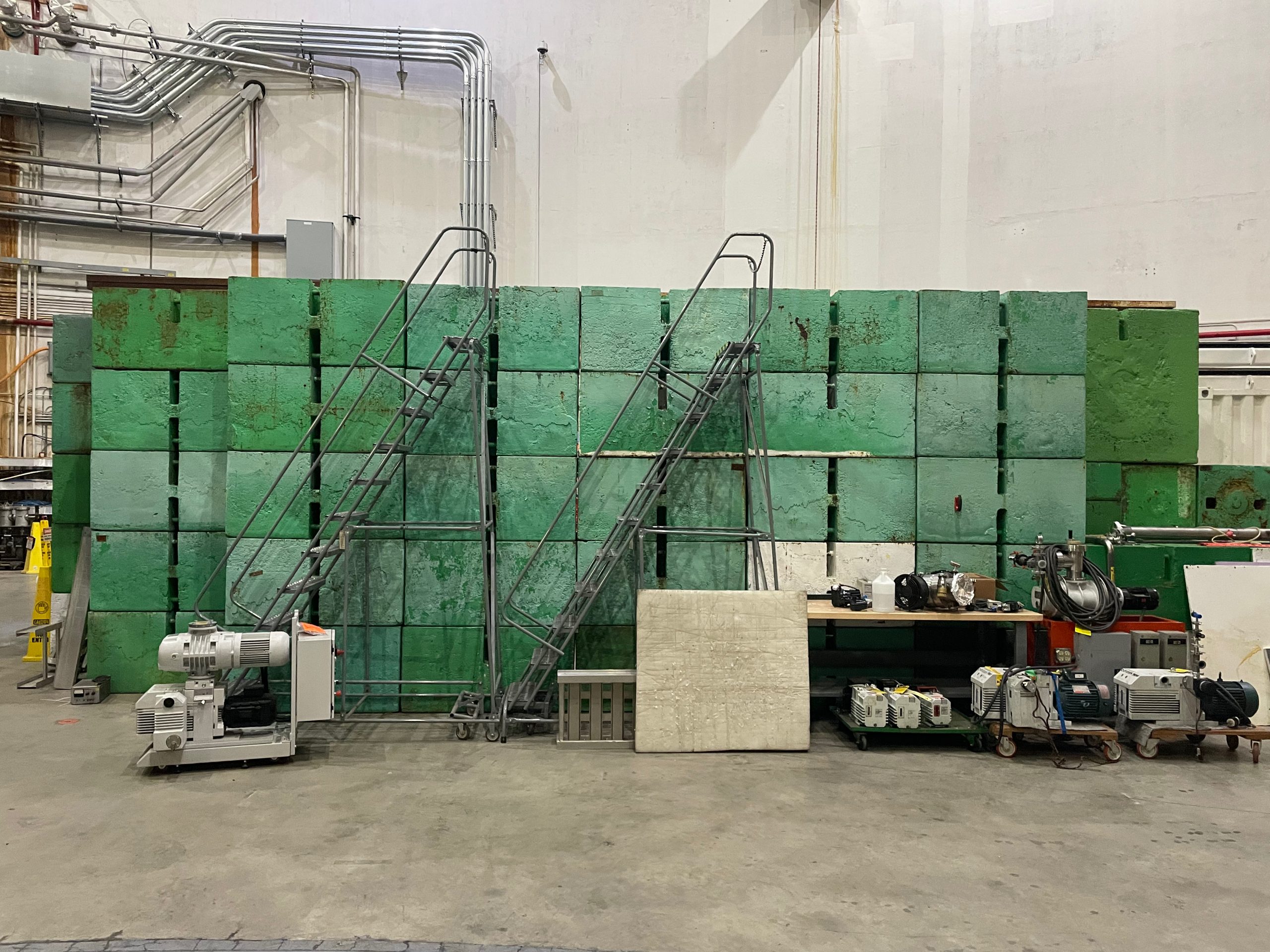Current UConn PhD students and group members Provakar Datta and Sebastian Seeds were accepted to the National Nuclear Physics Summer School (NNPSS) to take place at MIT this July.
Author: Andrew Puckett
First two SBS experiments completed (Feb. 2022)
From Oct. 2021-Feb. 2022, experiments E12-09-019 and E12-20-008 were completed in Jefferson Lab’s Experimental Hall A. Data were collected that will determine the neutron’s magnetic form factor (GMN) in a previously unexplored Q2 regime up to 13.6 (GeV/c)2 with unprecedented precision. These experiments were the first large-scale deployment and operation of Gas Electron Multipliers (GEMs) in the high-luminosity, high-radiation, high-background-rate environment in Hall A. The GEMs were used in this experiment for charged-particle tracking through the BigBite Spectrometer. Given the large channel count and the high occupancy of the BigBite GEMs in Hall A (approximately 42,000 readout strips with up to 30-40% of these firing in every event), the SBS GMN run produced 2 petabytes of raw data (or typically about 1 GB/s during beam-on conditions). This is roughly 5 times as much raw data produced in four months of beam time in Hall A as the previous 25 years of Hall A running combined. The UConn group was one of the most actively involved in the preparation and execution of the experiment, developed the Monte Carlo simulation, event reconstruction and data analysis software, and is now leading the analysis of the collected data. Two UConn Ph.D. students will write their doctoral dissertation on the analysis of the SBS GMN dataset.
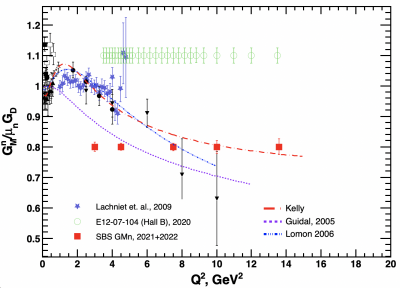
Figure 1 shows the collected Q^2 points for the extraction of GMN and the projected accuracy based on the data obtained, compared to existing data, selected theoretical models, and the projected Q2 coverage and precision of a measurement in Hall B with similar physics goals, but qualitatively different sources of systematic uncertainty.
The example event distributions shown below were obtained at an incident electron beam energy of 6 GeV and Q2 = 4.5 GeV2:
 Loading...
Loading...
Figure 2 (above) shows the invariant mass distributions for reconstructed electrons in BigBite, from the hydrogen (left) and deuterium (right) targets, before and after applying cuts on the angle between the reconstructed momentum transfer direction and the reconstructed scattering angle of the nucleon (proton or neutron) detected in the SBS hadron calorimeter (HCAL). The hydrogen distribution shows a clear peak at the proton mass corresponding to elastic scattering, and the angular correlation cut removes most of the inelastic background, while keeping most of the events in the elastic proton peak. The deuterium distribution is “smeared” by the Fermi momentum of the bound nucleons in deuterium, and the distributions of events passing the angular correlation cut under the hypothesis that the detected nucleon is a proton (red) or neutron (blue) illustrate the relatively clean selection of quasi-elastic scattering and rejection of most inelastic events using the SBS dipole magnet and hadron calorimeter.
 Loading...
Loading...
Figure 3 (above) illustrates the method for nucleon charge identification using the SBS dipole magnet and the SBS hadron calorimeter. The plot shows the difference in vertical position between the detected nucleon at HCAL and the expected position predicted from the reconstructed electron kinematics assuming elastic (or quasi-elastic) scattering. The distributions are shown for hydrogen and deuterium targets for three different SBS magnetic field settings (magnet off, 70% of maximum field, 100% of maximum field). The hydrogen distributions show a single peak corresponding to elastic electron-proton scattering, that moves as the SBS magnetic deflection is varied. The deuterium distribution with field off shows a single nucleon (proton plus neutron) peak, smeared by Fermi motion. The deuterium distributions with SBS field on show a clear separation into proton (deflected) and neutron (undeflected) peaks, with protons undergoing the same average deflection as seen with the hydrogen target.
New high-Q^2 form factor results published in PRL
New precision cross section measurements for high-energy elastic electron-proton scattering from Jefferson Lab’s Hall A have recently been published in Physical Review Letters. The measurements significantly improve the precision of the world’s knowledge of the proton magnetic form factor at large momentum transfers and establish that the discrepancy between extractions of the proton’s electric/magnetic form factor ratio from cross section and polarization measurements persists to large values of Q2. The supplemental material for the publication can be found here. The preprint of the accepted manuscript, titled “Form Factors and Two-Photon Exchange in High-Energy Elastic Electron-Proton Scattering” can be found on the arXiv.
SBS Installation in Hall A at Jefferson Lab, July 2021
Professor Andrew Puckett’s research group is currently leading, as part of a collaboration of approximately 100 scientists from approximately 30 US and international institutions, the installation in Jefferson Lab’s Experimental Hall A of the first of a series of planned experiments known as the Super BigBite Spectrometer (SBS) Program, with beam to Hall A tentatively scheduled to begin in early September of 2021. In addition to Professor Puckett, the UConn group’s involvement in this effort includes Postdoctoral Research Associate Eric Fuchey, and Graduate Research Assistants Sebastian Seeds and Provakar Datta. The first set of experiments is focused on the measurement of neutron electromagnetic form factors at very large values of the momentum transfer Q2, which essentially probe the spatial distributions of electric charge and magnetism inside the neutron at very small distance scales, on the order of 20 times smaller than the charge radius of the proton.
Electrons from Jefferson Lab’s Continuous Electron Beam Accelerator Facility (CEBAF), with energies of up to 10 GeV (=10 billion electron-volts), will scatter elastically from protons and neutrons in a liquid deuterium target in Hall A. Scattered electrons will be detected in the upgraded BigBite Spectrometer, located on the left side of the beam, while the high-energy protons and neutrons recoiling from the “hard” collisions with the beam electrons will be detected in the SBS by the newly constructed Hadron Calorimeter (HCAL), located on the right side of the beam. The SBS dipole magnet will provide a small vertical deflection of the scattered protons, which allows HCAL to distinguish them from scattered neutrons, which are undeflected by the magnetic field, but produce otherwise identical signals in HCAL.
The first group of experiments will answer several important questions about the “femtoscopic” structure of the neutron, including:
- What is the behavior of the neutron’s magnetic form factor GM at large momentum transfers? The SBS experiment will dramatically expand the Q2 reach compared to all previously existing neutron data, from approximately 4 –> 14 (GeV/c)2. See original experiment proposal here. Figure 1 shows the projected SBS data together with existing data and selected theoretical predictions for the high-Q2 behavior of this form factor.
-
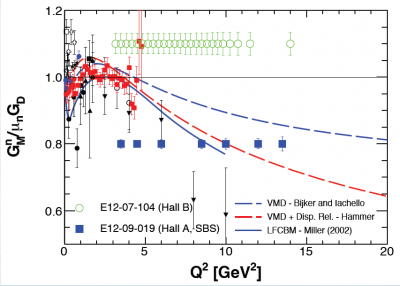
Figure 1: Projected SBS program results on the neutron magnetic form factor, compared to existing data and selected theoretical predictions - How is the charge and magnetism of the proton shared among its “up” and “down” quark constituents as a function of Q2? The proton magnetic form factor has been measured over a much wider range of Q2 than the neutron, and combined proton and neutron measurements can be used to disentangle the contributions of “up” and “down” quarks (and diquark correlations) to the proton’s structure, under the assumption of charge symmetry of the strong interactions (see, e.g., https://inspirehep.net/literature/1812076)
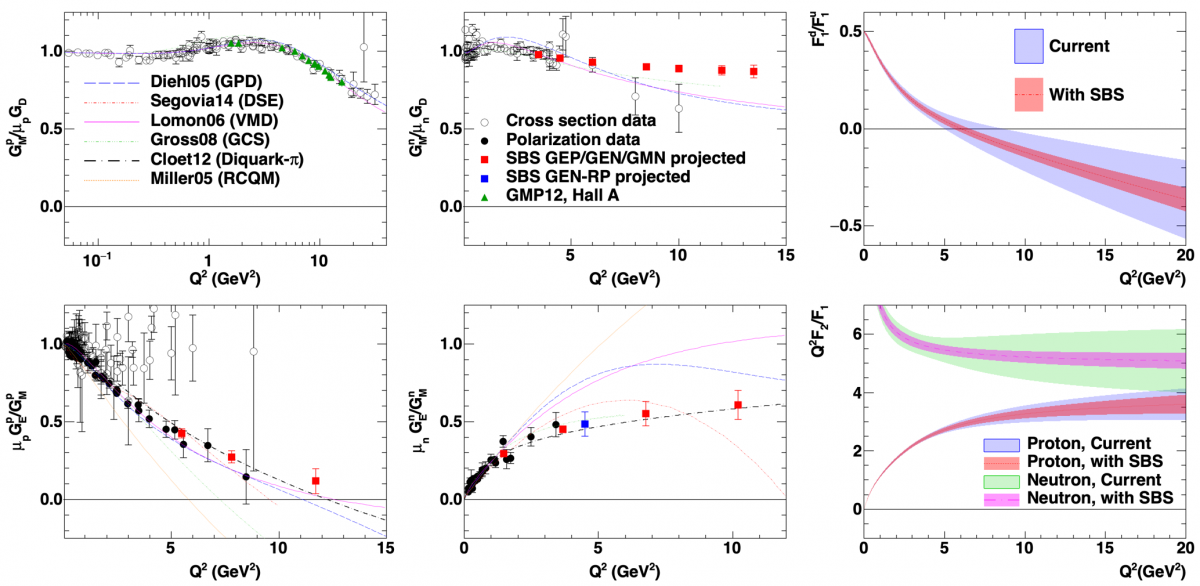
Projected results on nucleon electromagnetic form factors at large momentum transfers (Q^2) from the upcoming SBS program in Hall A at Jefferson Lab. See https://inspirehep.net/literature/1812076 for more details. - How important and/or significant is the contribution of two-photon-exchange to elastic electron-neutron scattering? The first SBS experiment group will perform measurements of the electric/magnetic form factor ratio for the neutron using two different techniques known as “Rosenbluth Separation” and “Polarization Transfer”, at a Q2 where these two techniques have shown significant disagreement for the proton. Both measurements will be the first of their kind for the neutron at such large Q2 values (see, e.g., Polarization Transfer Proposal and Rosenbluth Separation Proposal).
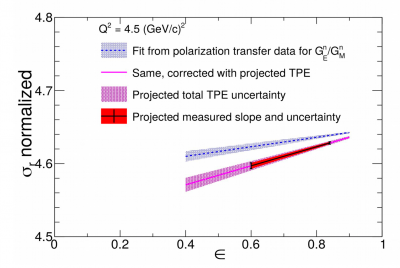
Projected results of the planned Rosenbluth Separation measurement of the neutron form factor ratio, to be compared with the companion polarization transfer measurement of the same ratio at identical kinematics. The experiment will provide a precise test for the neutron of theoretical calculations of two-photon-exchange contributions thought to explain the discrepancy observed for the proton.
SBS SIDIS experiment (E12-09-018) jeopardy proposal re-approved by PAC49
Experiment E12-09-018 (the SBS SIDIS experiment) in Jefferson Lab’s Hall A, first approved by JLab PAC38 for 64 beam-days with an “A-” scientific rating in 2011, was evaluated under the Jefferson Lab Program Advisory Committee’s jeopardy process, which periodically reconsiders the approval status, beam time allocation, and scientific rating of experiments which have been approved but not yet scheduled after a certain amount of time. The experiment is currently expected to run some time in 2023. PAC49, held during July 19-23, considered the continued science motivation for the experiment and reviewed the progress in the preparation of the experiment since it was first approved, and re-approved it with no change in beam time allocation or scientific rating.
- Jeopardy proposal (re-approved July, 2021)
- PAC38 proposal (approved August, 2011)
The experiment will measure so-called “single-spin asymmetries” (SSAs) in the production of charged and neutral pions and kaons in “deep inelastic” collisions of CEBAF’s continuous electron beam with transversely polarized neutrons in Helium-3 nuclei (transversely polarized means that the spin-1/2 Helium-3 nuclei, and therefore the unpaired neutrons they contain, have their nuclear spins preferentially aligned perpendicular to the direction of the electron beam). These asymmetries are sensitive to the orbital motion and transverse polarization of the neutron’s elementary quark constituents, and can provide for three-dimensional “imaging” of quarks’ motion and spin inside the neutron. The kinematics of the collisions, known as “Semi-Inclusive Deep Inelastic Scattering (SIDIS)” are chosen such that the cross section for the observed reaction is dominated by hard scattering of electrons by quasi-free quarks in the target neutron, and independent “fragmentation” of the recoiling quarks into observable hadrons (pions, kaons, etc).
By using the BigBite and Super BigBite spectrometers in Jefferson Lab’s experimental Hall A, together with an advanced, high-pressure helium-3 gas target polarized via spin-exchange optical pumping, that can withstand very high electron beam currents, the SBS SIDIS experiment will measure the SSAs for production of pions and kaons in “hard” electron-quark collisions on a neutron target with statistical precision 10-100 times greater than any previous experiment on either a proton or deuterium target. Measurements of SSAs involving transverse polarization of the nuclear spins are extremely challenging from an experimental point of view, and as such, very little new data have been collected on these effects for roughly the last decade. The SBS SIDIS experiment represents the best near-future opportunity to make significant experimental progress on these observables.
Figure 1 shows an example of the projected results of the SBS SIDIS experiment for π+ production on the neutron compared to existing data on proton and deuteron targets.
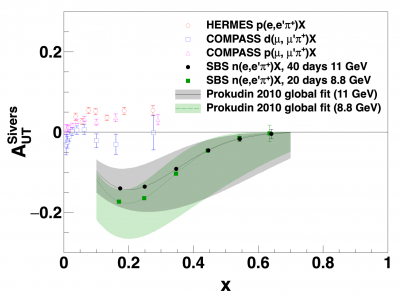
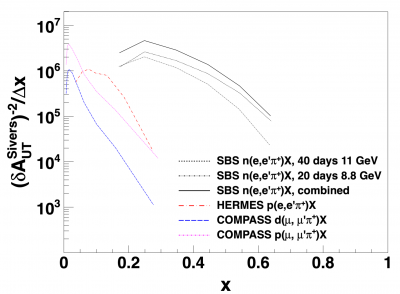
Professor Puckett Elected to Jefferson Lab Users’ Organization Board of Directors
Professor Puckett was elected by the Jefferson Lab User Community to a two-year term as an at-large member of the Jefferson Lab Users’ Organization (JLUO) board of directors (BOD).
More information about the JLUO, the BOD and their activities can be found here:
https://wiki.jlab.org/cugwiki/index.php/Main_Page#tab=Board_of_Directors__28JLUO_BoD_29
New paper published on future positron-proton polarization transfer experiment
The European Physical Journal A has now published a paper led by Professor Puckett together with Professors Axel Schmidt of George Washington University and Jan Bernauer of Stony Brook University describing a future experiment to measure polarization transfer in positron-proton elastic scattering at large momentum transfers. These measurements would provide new information to constrain the effects of multi-photon-exchange in elastic lepton-proton scattering, thought to explain the discrepancy between cross section and polarization measurements in extractions of the proton electromagnetic form factor ratio at large momentum transfers.
https://inspirehep.net/literature/1860752
https://doi.org/10.1140/epja/s10050-021-00509-5
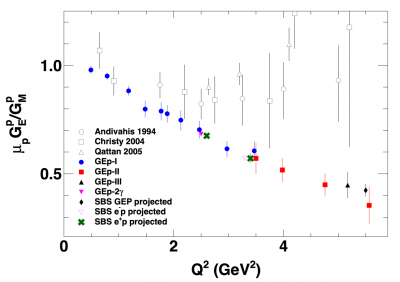
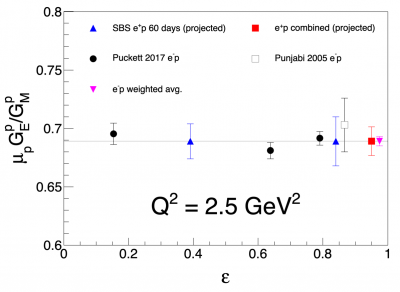
New precision measurements of proton form factors at high energy
The Hall A Collaboration at Jefferson Lab is reporting new precision measurements of the cross section for elastic electron-proton scattering at large values of the momentum transfer Q2 and low values of the virtual photon polarization ε. These new data significantly improve the precision of our knowledge of the proton’s magnetic form factor at large Q2 values. When combined with existing high-ε data at similar Q2, the new Hall A data allow us to nearly double the Q2 range for which it is possible to directly separate the contributions of longitudinally (L) and transversely (T) polarized virtual photons to the cross section, in a procedure known as Rosenbluth separation or L/T separation. In the one-photon-exchange approximation, this procedure allows us to separate the electric (GE) and magnetic (GM) contributions to the scattering. The new data are consistent with approximate form factor scaling; i.e., μp GE/GM = 1 (here μp = 2.79284734462(82) (according to PDG), is the proton’s magnetic dipole moment in units of the nuclear magneton). This result contradicts the expectations for this ratio based on precise measurements of the proton’s electric/magnetic form factor ratio using the polarization transfer technique. The new data significantly increase the range of Q2 for which significant two-photon-exchange contributions to the elastic electron-proton scattering cross section are conclusively established.
A manuscript reporting the new results has been submitted to Physical Review Letters. The preprint of the manuscript can be found here.
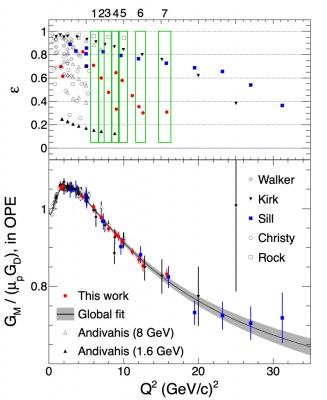
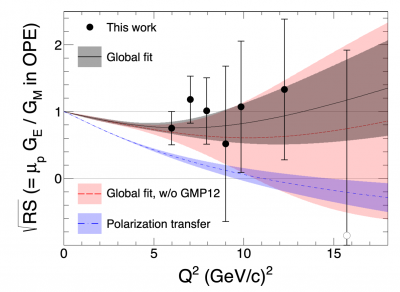
New precision measurement of the neutron skin thickness of Lead-208
The PREX/PREX-II collaboration is reporting new measurements of the parity-violating asymmetry in elastic electron scattering from the Lead-208 nucleus. This asymmetry, which is generated by the interference between the electromagnetic and weak neutral current interactions between the electron and the nucleus, is highly sensitive to the difference in size between the proton and neutron distributions in the Lead-208 nucleus.
The new measurement improves on the statistical precision of the PREX-I measurement by more than a factor of 3, and has significant implications for the size and composition of neutron stars.
- Preprint of the manuscript reporting the PREX-II result, prepared for submission to Physical Review Letters
- The PREX-I result, published in Physical Review Letters in 2012
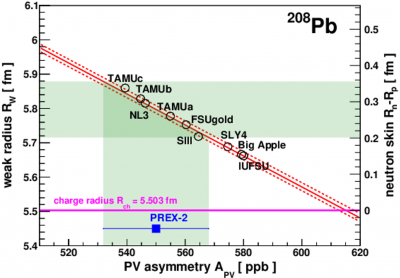
New Nature publication: More anti-down quarks than anti-up quarks in the proton
The SeaQuest/E906 Collaboration at Fermilab has published new data on measurements of the ratio of anti-down over anti-up quarks in the proton, obtained by studying the Drell-Yan process in collisions of a 120 GeV proton beam from the Fermilab main injector with protons and neutrons in liquid hydrogen and deuterium targets.
In the Drell-Yan process, quark-antiquark annihilation events are clearly identified by detecting high-energy muon-antimuon pairs resulting from the annihilation of a quark (antiquark) in the beam proton with an antiquark (quark) in the target proton or neutron.
By studying Drell-Yan events in kinematics dominated by beam quarks and target antiquarks with large momentum, and comparing measurements on hydrogen and deuterium under the assumption of charge symmetry (same number of down/anti-down quarks in the neutron as up/anti-up quarks in the proton), the collaboration was able to establish an excess of anti-down quarks over anti-up quarks in the proton. This important and highly anticipated result has no clearly agreed-upon theoretical explanation, and contradicts naive expectations of quark “flavor” symmetry in the antiquark distributions.
The paper can be read here.
